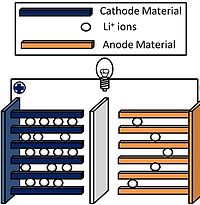
Photo from wikipedia
Abstract Precise control over particle composition and morphology is essential for the optimization of electroactive, multi-component transition metal oxides used as lithium-ion battery cathode materials. These transition metal oxide particles… Click to show full abstract
Abstract Precise control over particle composition and morphology is essential for the optimization of electroactive, multi-component transition metal oxides used as lithium-ion battery cathode materials. These transition metal oxide particles are often synthesized using precursors produced via coprecipitation reactions, in part due to the advantages provided by coprecipitation including scalability and homogeneous mixing of different transition metal ions. Understanding the kinetics of the nucleation and particle growth for each individual transition metal within a multicomponent blend solution is critical for rational and explicit control of particle composition, as well as to dictate the particle morphology. In this study, in-situ particle size distribution was measured during coprecipitation reactions using focused beam reflection. The transition metal concentrations were also in-situ tracked during the process which, in combination with the particle size information, provided detailed information on the reaction rate, reaction order, and mechanisms of particle nucleation and growth. This work is the first demonstration of application of such techniques to battery precursor particle synthesis, and provides insights into important observations during the coprecipitation process such as the change in the rate of coprecipitation of different transition metals when reacted in isolation or in a blend with other components. The techniques and analysis demonstrated in this paper could find application across many multicomponent transition metal coprecipitation systems important to various applications, including energy storage materials.
Journal Title: Colloids and Surfaces A: Physicochemical and Engineering Aspects
Year Published: 2018
Link to full text (if available)
Share on Social Media: Sign Up to like & get
recommendations!